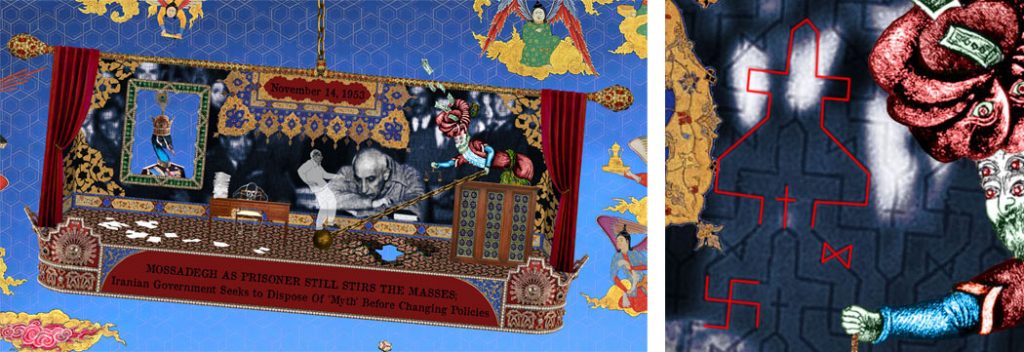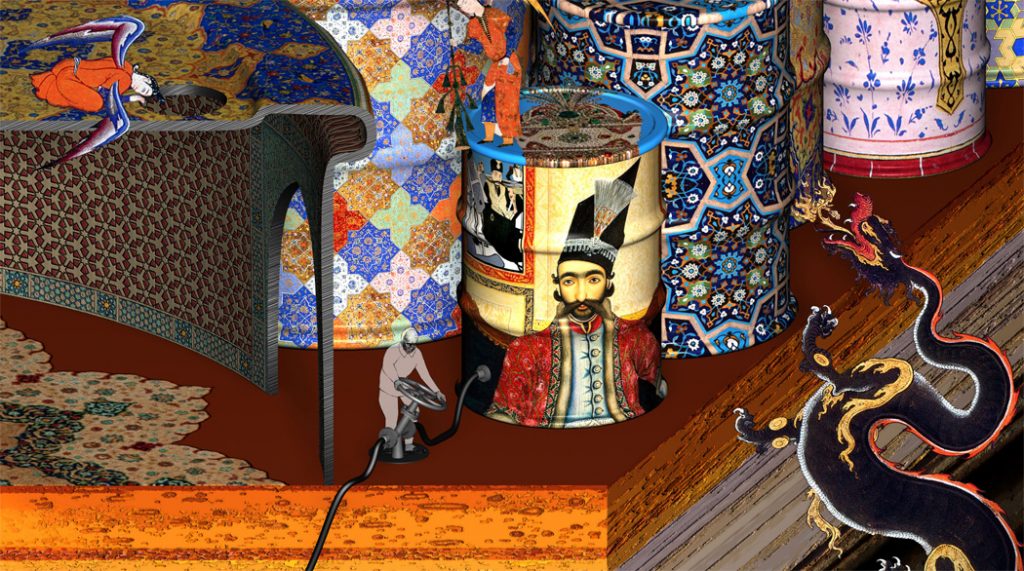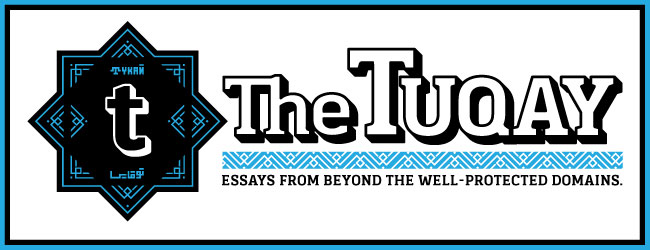This piece was originally published on The Tuqay before it became part of Ajam Media Collective.
The Cat and the Coup is a documentary videogame created by Peter Brinson and Kurosh ValaNejad. You can find their website, and the link through which to download the game for Mac or PC for free, here. Like any good documentarians, Brinson and ValaNejad make liberal use of artistic cues – visual and aural – to immerse the gamer into the virtual world. In their world, the gamer plays the role of Mohammad Mossadegh’s cat, coaxing Mossadegh through significant events in his life.
You can watch the trailer or play the game for yourself if you want to know more about gameplay. And you certainly should do both of those things. In this interview with Kurosh ValaNejad, we focused on the artistic output that gave the game life and context. We were interested in the surreal, Terry Gilliam-esque world that ValaNejad created for his gamers to experience. We wanted to know what inspired this world and how it was visually created. Kurosh was kind enough to answer some questions and provide the desired context. So without further ado, the interview…
1) The Cat and the Coup has a very distinct visual style. How did that come about? Did the idea of creating a game in a Persian Miniaturist style come first, or did the game come first and this style seemed the best way to breathe it to life?
Peter Brinson had the idea to make this game and was using pen and ink drawings for its look. It was beautiful but didn’t seem particularly relevant. Instead I suggested we consider the pen and ink drawings of Iranian political cartoonist Ardeshir Mohasses. In his illustrations from Life in Iran (Library of Congress, 1975-79) he satirized Iran’s ruling dynasty, the Pahlavis by dressing themin the attire of the previous dyansty; the Qajars. By placing social and political events of the time in historic surroundings, Mr. Mohasses drew attention to broader issues. This approach also seemed appropriate for our project, as we hoped to generate discourse about the ironic cost of democracy, as opposed to condemning individuals.
My mother is an old friend of Mr. Mohasses and has a large collection of exhibit catalogues and personal notes. While looking over their 30 year of correspondence, I noticed Mr. Mohasses favored illustrations from Persian manuscripts, often sending his notes on museum postcards. That’s when I started re-imaging the our videogame in the style of Persian miniatures.

2) Where, exactly, did the patterns and images come from? Did you have a stock full of them, or really try and seek out the right forms for the right rooms?
Finding high quality facsimiles of Persian miniatures was a challenge. Images on the internet were too low in resolution, and books on the topic are out of print. I dredged unsuccessfully through online used book sites like eBay and Biblo.com, occasionally finding a treasure.That’s when I reached out to the Los Angeles County Museum of Art, which houses one of the most significant collections of Islamic Art in the world. Linda Komaroff, curator of Islamic art and head of the Middle East Art department, gave me access to the museum library, including the rare and oversized books in her office. This goldmine of patterns provided the resources to realize the game world with as much detail as I could imagine. I tried to match patterns to the particular events in the game. For example, in the second room of the videogame, Mossadegh is on trial for treason. We wanted the room to look like a show trial under the control of the King. I constructed the room from his crown. And for the the room’s wallpaper, I used a pattern with elements symbolic of the monarch who was harshly characterized as a Playboy and a puppet of the West. These symbols include jet planes, bow ties, Christian crosses, and the swastika (The Pahlavi pact with the Nazi party during World War II led, in part, to the abdication of Reza Khan, the dynasty’s founder.)

3) How important was it to keep up the miniaturist style, and how did you tackle the problem of bringing mid-20th-century imagery together with miniaturist imagery in the very 21st century sphere of video games?
Merging the various styles was surprisingly easy. And players do not seemed jarred by the mash-up of art from across centuries. I am guessing this is because of our exposure to the Postmodern techniques in contemporary Art. This is how Wikipedia defines Postmodernity; “There are several characteristics which lend art to being postmodern; these include bricolage, the use of words prominently as the central artistic element, collage, simplification, appropriation, performance art, the recycling of past styles and themes in a modern-day context, as well as the break-up of the barrier between fine and high arts and low art and popular culture.” The art-direction of The Cat and the Coup strives to be an example of that art movement in the form of a videogame.

4) What other inspirations do you have? Between the animation and the music, there are definite noire-ish overtones. What sort of mood were you going for in making this game, and how did you go about that?
The 1953 coup was a tragic moment in Iranian-American relations (not just for Iranian democracy, but arguably more so for America’s.) The tone of the videogame reflects that through its pacing and Peter Brinson’s haunting sound design that mixes music from Nine Inch Nails’ Ghost IV 36, Erik Satie’s Gnossienees No. 1 –Lent, and Peter’s own musing with seemingly random notes.
5) There are other aspects to the game, once you go further, that remind me a lot of Terry Gilliam. The shah’s head is a peacock; the protestors have heads of books. There’s a lizard, a giant pig, and other strange images. What made you choose such surreal imagery? Were there any particular favorites of yours? So what’s the story behind the different animals anyways?
The animal avatars are inspired by the historic characters. Some are obvious. Persian kings have ruled from the Peacock Throne since the 18th century. And Winston Churchill’s mannerisms and appearance gave him the nickname of the British Bulldog during World War II. Others require more thought, and perhaps some imagination. I used the horny toad to represent CIA agent Kermit Roosevelt Jr. for a few reasons. Its horns resemble the points of the star in the CIA logo (which I also placed on the chest of the character) and the sneaky modi operandi of spies seems very lizard-like.
The pig tank is one of my favorites. It represents Fazlollah Zahedi, the Iranian general who conspired with the CIA to overthrow Mossadegh. He ultimately replaced him as the Prime Minister. During play-testing, students identified the pig tank as ‘World Police,’ and were able to trace the root of the coup in the tracks of the tank – from dollar signs back to the English Pound.
6) Is there any symbolism behind the tilting levels? Or is that just a gameplay dynamic?
The game mechanics of The Cat and the Coup are allegorical. For example in Room 1 the player as cat knock’s down Mossadegh’s inkwell as he is writing his memoirs. The cat’s indirect manipulation of Mossadegh represents the covert actions of the CIA. The leaked CIA documents mention bribing members of the Iran’s media, Mullahs, merchants, military and the Majlis, Iran’s parliament. The cat’s weight tilts the rooms, keeping Mossadegh constantly off-balance.
7) Do you have any favorite levels? Anything you were very skeptical about when you started, but proud of in the finished product?
The last level/room is my favorite as it illustrates a connection I have not seen published anywhere. Mossadegh is known as the Nationalist hero of Iran. But he did not start the movement. In 1890, Nasir al-Din Shah, a Qajar King, granted Iran’s tobacco concessions to Great Britain. In retaliation the entire country boycotted tobacco. This was the first nationalist act of Iranians. How karmic for Mossadegh, a descendant of the Qajar dynasty, to lead the movement to retrieve Iran’s national resources (like its oil) back from foreigner control.

8) How much does making the game easy – as in, it can be completed within a half hour – fall into making the game educational?
The Cat and the Coup is an experiment in game-based education. By keeping the videogame short and abstract, we hope to tap into the intrinsic curiosity of young people. This less didactic approach to teaching encourages personal interpretation and motivates self-learning. Since it is played on a computer, students often follow gameplay with searches on the internet for more of Mossadegh’s story. Considering the politically-charged nature of this history, we reduce the perception of propaganda by encouraging players to find their own truth.
Note: The images used to illustrate my answers are from the Where’s Waldo Edition of The Cat and the Coup. This version of the game is a large format print of the entire game world of the videogame. It is designed to be investigated with a magnifying glass, giving students an opportunity to thoroughly examine the coded narrative in the artwork, and reflect on the meaning of their gameplay. The prints were made during a 10 week artist residency program at Anderson Ranch Arts Center in Colorado, in Spring, 2012.













2 comments
Comments are closed.